Esther O’Kelly
Visual Artist
Out of the Field and Onto the Canvas: Esther O’Kelly on Creative Disorientation, Confidence, and the Path Through The Stray Sod and Seachrán Sí
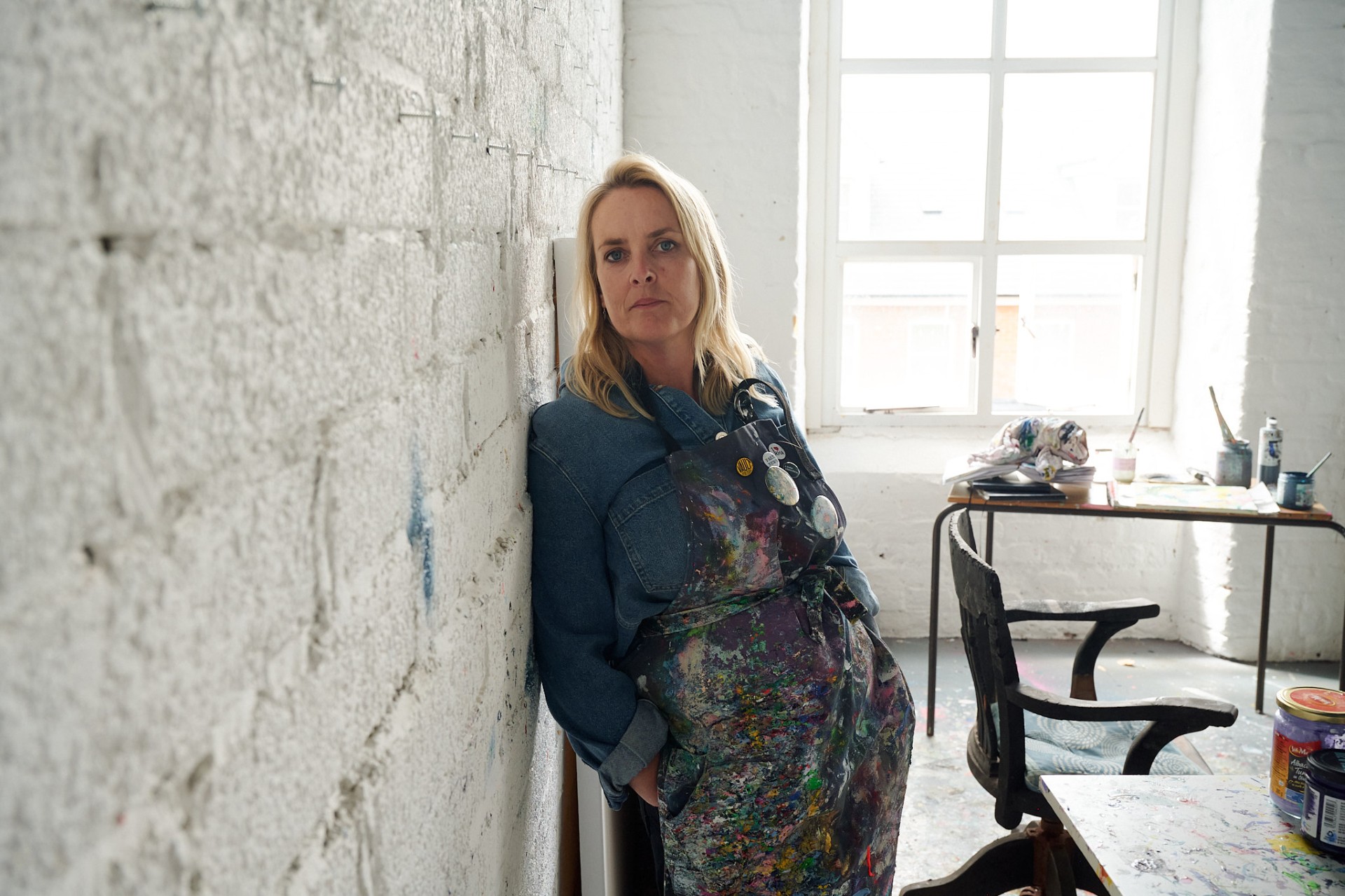
Esther O’Kelly doesn’t paint like she’s following a map. She paints like she’s gotten lost – and likes it. Her practice, rooted in paint and landscape, moves with the logic of instinct, weather, and memory.
Some of her earliest tools were gathered not from art shops, but from her mother’s kitchen drawer – old icing spatulas that proved unexpectedly useful in shaping and scraping her work. Later, she turned to her father’s Opinel knives, originally used for fishing net repairs, discovering their perfect balance of sharpness and flexibility for pulling paint. These inherited tools, filled with memory and function, became part of her unique mark-making language. From her home in Belfast, she spoke to Go Leor about what it means to work within disorientation, the discipline of letting things sit unfinished, and why she’s still in the field, looking for the light.
Photo Credit Kate Donaldson
“The practice is very much about disorientation and discovery”
“I had this idea for a show, but I’m not finished yet,” she says. “I still… it’s still kind of like in my head and it’s still where I’m at with the practice.” That idea – The Stray Sod – has recurred across multiple exhibitions and continues to guide her studio practice. One such iteration appeared at the Pig Yard Gallery for the Wexford Opera Festival, but the concept has remained central and generative. “It’s ironic really,” she adds, “because the whole concept of that… you know what that’s about, you know, people getting stuck in fields.”
Known in Irish folklore as Seachrán Sí, this idea of becoming disoriented or led astray – sometimes by spirits, sometimes by a flickering light – offers Esther both a visual and emotional framework: a metaphor for the artistic process itself.
“That’s actually just such a strong metaphor for the studio practice,” she says. “The idea of people following lights – like in Wales, where they call it the will-o’-the-wisp or ‘Pwca’ or ‘Ellylldan’ – those flickering lights in marshes that are said to lead people astray. I think that’s how artists work anyway – If there’s no light in the work, it’s just a void.”
For Esther, light becomes both literal and metaphorical – a visual anchor and a navigational tool within the emotional terrain of painting. The folklore of the Seachrán Sí, in which a person might become lost in a field unless they find and follow a mysterious light, maps precisely onto her relationship with creative progress. “You kind of do follow the light in the painting,” she reflects. “The practice is very much about disorientation and discovery in the work… it keeps my head in it and occupied. And it also makes me laugh, you know, because I have been stuck in a fair few fields in my life.”
Her paintings emerge from that process – the following, the uncertainty, the pull toward some faint glimmer. “My work is about people and place and landscape… I find that like a really kind of fruitful ground for the work at the minute.”
Seasonal change plays a profound role in how Esther experiences and creates her work. She speaks of winter as a time when the world contracts – when the absence of light can provoke both introspection and instability. During a residency in The Tyrone Guthrie Centre, she encountered Brendán Begley, master of traditional Irish accordion playing and a native Irish speaker from Kerry, who described January with the phrase “síos síos síos” – down, down, down – capturing the spiral so many experience in the darker months. For Esther, this idea resonated deeply. “In the winter,” she says, “I go really feral in the studio,” describing periods of creative chaos and internal disorientation. But these spirals are not voids – they are the undergrowth, the buried seeds of spring. Out of this seasonal descent comes eventual renewal, a return to light and canvas.
“It’s like a health farm for artists”
Time and space are necessary to her process – and hard won. “I’ve got a family, so I haven’t really had the opportunity to leave home much,” she shares. But a recent residency in Monaghan changed something. “What was really incredible about it was how central the artist is to the place… there’s a real nourishing, homely kind of atmosphere about it.”
She describes the experience with a kind of wonder: “Everyone says your name over and over… you’re at the centre of the table and there’s conversation all around you… you go through your life feeling like it’s not a valued profession… then you go to these places and you realise actually it’s a really important job.”
That contrast is stark. Back in Belfast, she says, “We have this phrase… ‘Suitable for Artists or Storage,’” referencing a project started by her friends Neal Campbell and Jane Morrow in response to the state of artist studios in the city. And yet, even with such limits, she’s built a career with stubborn generosity – opening her studio to her children and their friends, despite the chaos it sometimes brings.
She also mentions artist Eimear Maguire, whose profile in Go Leor she had read and who she personally knows. Esther speaks with clear admiration: “She’s been around a while and she works on her own from home, and she’s got an awful lot going for her, like, you know.” Reflecting on the transformative effect of Eimear’s recent residency, she adds, “You could see what happened to her when she went on residency. You can see how it transformed her work so quickly… it just allowed her then to kind of flourish.” Esther’s appreciation is both personal and artistic: “She’s one of these people that is just like, you know, buzzing all the time… you can see her a mile away, like she’s just so radiant and just, you know, just has all this incredible stuff going on in their head.”
Photo Credit Kate Donaldson
“I don’t want to show you what it looks like – I want to show you what it feels like”
“I have climate anxiety just like the next person,” she confesses. “So I think half of the time, how I’m coping with it is I’m escaping into the landscapes.” But these aren’t gentle escapes. “They’ve always been supernatural and quite intense and not calm places… there’s a little bit of turmoil in them, you know?”
Growing up in Rosslare’s shifting coastal terrain, that feeling has been lifelong. “We were constantly anxious about my father’s house, my auntie’s house… pretty much a king moon and high tide would take them.” Some parts, like The Fort, have already disappeared, swallowed by nature’s relentless reshaping. Until the mid‑1920s, a long sand‑spit extended north from Rosslare, ending with a small fort – Rosslare Fort – protecting Wexford Harbour. But a severe storm in the winter of 1924–25 breached the spit, and progressive erosion washed both the fort and its land away. Today, the only trace visible is a lonely island revealed at low tide.
The loss of The Fort stands as a stark reminder: the land that nurtured generations can vanish in a heartbeat, and with it, the memories it held.
She mentions her husband, Paul, co-founder of Brink! a platform for discussion, education and action centred on the issues of climate breakdown, who is deeply involved in climate and sustainability. “That’s why I say I have to be careful when I talk about environment,” she says, “because it’s so complex. But I feel like my work is reacting to it.”
Her response isn’t documentation – it’s emotional cartography. “It doesn’t make sense for me to document a landscape. I want to talk about how it feels.” She works from sketchbooks made while walking. “I draw while I’m moving… I just want to kind of feel and hear everything.”
When it comes to finishing a painting, she holds herself to a particular kind of resolution: “It needs to end on a high note… but I’m not done with this notion yet, so I have to move it on to the next piece.”
“You go through school thinking you’re a bit thick”
Esther speaks candidly about her struggles with dyslexia and school in the 80s and 90s. “You go through school thinking you’re a bit thick… then you arrive in art college and realise, ‘Oh, I’ve found my people.’”
In spaces where her way of thinking made sense, Esther began to realise she wasn’t lacking – she’d simply been in the wrong room. School had underestimated her, even discouraged her from applying to NCAD (National College of Art and Design), saying no one from her school ever got in. But she did. That shift in environment didn’t erase the challenges – but it reframed them.
Numbers, she says, were “double Dutch,” and writing coherently never came easily. “So for those reasons, it’s taken me a long time to get over being in front of people and speaking with any authority. Actually, I would find presentations and talks quite a challenge.” But she’s reached a point where that no longer stops her.
Finding her place among artists didn’t just affirm her abilities – it gave her the confidence to speak, share, and teach, even if that journey took time. Art college wasn’t just a change of direction. It was a change in atmosphere – where difference was not just accepted, but essential.
She credits the artist Joy Gerrard, who mentored her, with helping shift her perspective. “She’s very generous,” Esther says. “She would say, just ring me if you ever want to talk anything through.” When she doubted whether she was qualified to present her work publicly, it was Joy who reminded her: “Maybe they want to know about your practice.”
Esther’s still learning to speak about her work with confidence. “It’s taken me a long time to get over being in front of people… but the reason I do them now is because I just don’t give a shit anymore.” Her humour and honesty crackle. “You start seeing people around you, half your age… confidently embracing their space and you just go, ‘Oh, I’m holding myself back here.’”
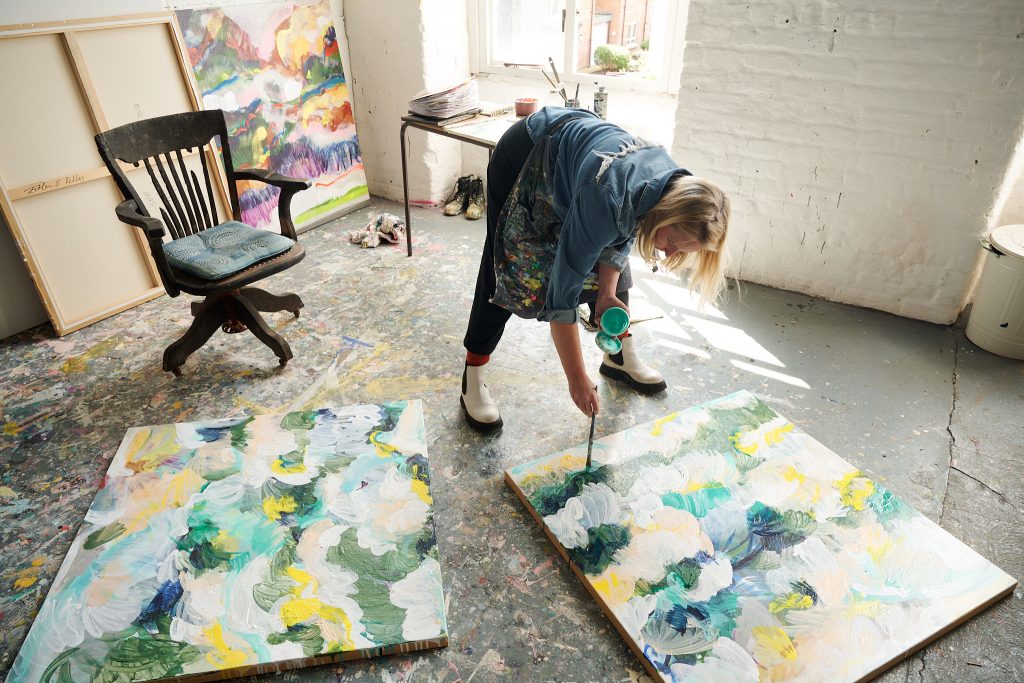
“It starts with pacing – and storytelling”
Esther’s studio process is as instinctive and layered as her paintings. “I cycle down, go in, open all the windows. And I literally, I pace,” she says.
Her studio rituals are quiet and sensory – filled with brushes, textures, light, and sound. In the past, she had a coffee machine there. Now she prefers to arrive gently, take her time, and prepare internally before making a mark.
A key part of her preparation is sound. “I can’t read or anything when I’m painting,” she says, “so I listen to a book usually.” She’s drawn to writers like Robert Macfarlane, Nan Shepherd, Roger Deakin, and Elif Shafak – storytellers of land, water, and time. One recent painting was inspired directly by Shafak’s There Are Rivers in the Sky, a poetic imagining of a single drop of water’s life across centuries.
When not listening to books, she gravitates to musicians who work with narrative and atmosphere: Joshua Burnside, Junior Brother, and Lankum. Their songs, she says, help her “go on a journey,” tracking feeling and pace. “It has to be narrative for me… almost like a journey.”
And then, sometimes, when the painting is done – and only then – the tone shifts. “If a painting was good, it’s a bit of techno maybe,” she laughs. “A lap of honour.”
Discover Esther’s recent work, along with the latest news via her website: estherokelly.com
Keep up with her on social media: @estherokelly
The Latest Articles
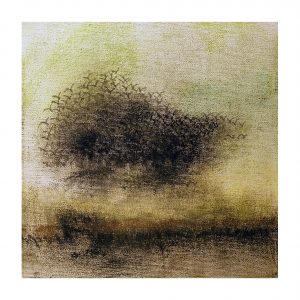
Bob Speers and the Quiet Magic of Ireland’s Bogs
In a room filled with timber, peat, and light, artworks hung on walls are more like fragments of the land itself – weathered, breathing, and alive with memory.
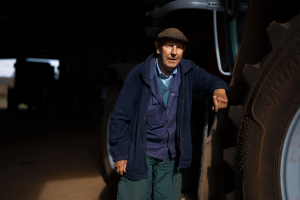
Hernan Farias on Light, Connection and Creative Growth
From the Classroom to the Camera – charting his shift from teaching English in Chile to full-time photography in Northern Ireland.
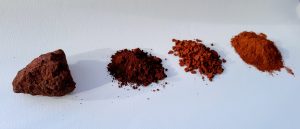
The Colour & Spirit of Time: Tricia Kelly’s Journey with Ócar
Exploring how sixty million years of volcanic fire, weather, and transformation created the red ochre that now colours Tricia’s life and work.
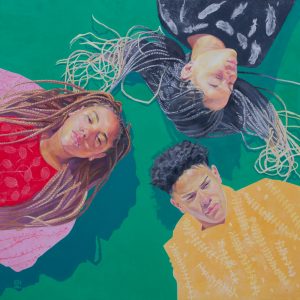
Faith and Colour: The Genuine Art of Beverley Healy
In her imaginative work, paint becomes prayer – a meditation on trust, surrender, and creation, where colour and stillness meet to form something transcendent.

Ruairi Mooney on Creativity, Practice & the Search for Authentic Art
From the North Coast to the Canvas: a journey of resilience, daily practice, and the slow discovery of an authentic artistic voice.

From Trauma Wards to Ceramics: Denise McAuley’s Authentic Creative Journey
From the trauma wards of the Royal to the shoreline of Cushendall, Denise creates small-batch ceramics that carry memory, resilience, & the rhythms of the sea.
